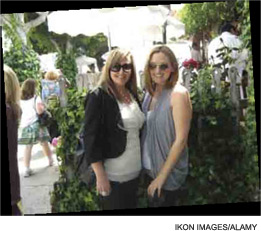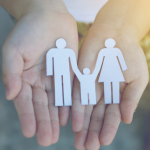It was April 1987, and 17-year-old Bridget Hood and her family were planning a spring break vacation from their California home to Hawaii. To prepare for the trip, the teenager booked several sessions in a tanning booth, determined not to look too pale on the beach. Little did she know that the excessive sun exposure would trigger immune system changes from genes encoded within her DNA, awakening a disease that, unbeknownst to Bridget and her family, went back at least three generations in the Hood family.
By the time Bridget returned from the Hawaii vacation, her body was covered in rashes, including the distinctive butterfly rash. She felt feverish and achy and it soon became clear that something was very wrong with her kidneys. Bridget was hospitalized to undergo a kidney biopsy, and and she and her family received the diagnosis on May 8, a day they will never forget. The diagnosis was systemic lupus erythematosus, the same disease, she now knows, that killed two great aunts and sickened her great-grandmother.
This powerful family history is why Bridget, now 40, and her youngest sister, Barbara Scholze, 33, were so eager to join the Sisters of Women with Systemic Lupus Erythematosus (SisSLE) study. They know their DNA has a story to tell. Bridget is just happy she’s still alive and well enough to help tell it, because her journey through the world of lupus over the past 25 years has been anything but smooth.

Steroids and Swelling
With the diagnosis of lupus, doctors put Bridget on high doses of steroids to stem the inflammation; she then began experiencing severe paranoia and hallucinations. A restrictive health insurance policy kept her from switching doctors, and her nephrologist—the only specialist she was seeing—was stymied. A year and a half later, Bridget returned to the hospital, severely malnourished, every part of her body swollen with fluid her kidneys couldn’t process. “The doctors said that if they could suck the water out of my body I would be so emaciated I would look as if I were starving to death,” Bridget, who now lives on Corona del Mar, Calif., recalls.
Doctors inserted a central line for parenteral nutrition and started cyclophosphamide. For the next three years, Bridget received monthly infusions that caused severe side effects. Sometimes she’d vomit 30 times in an eight-hour period, she remembers, because she was allergic to all available antinausea medications. Eventually, it began to feel as if the chemotherapy was producing more problems than the lupus. Finally, at age 22, Bridget told her doctor she couldn’t do it anymore.
Then other problems started. The years of high-dose steroids had led to avascular necrosis of the hips and knees. Barely out of her teens, Bridget now found herself using crutches and a wheelchair. Orthopedic surgeons didn’t want to replace her joints, however, worried that at her age it would contribute to further bone-density declines.
Treatment Breakthrough
Finally, she found Daniel J. Wallace, MD, clinical professor of medicine at the David Geffen School of Medicine at the University of California, Los Angeles and an international leader in lupus research and clinical care. “He totally changed my life,” Bridget says of Dr. Wallace. He referred her to an orthopedic surgeon who told her she was “too young not to be able to walk, you need to start living,” and replaced her right hip. Five years later, at age 28, he replaced the left one.
In the meantime, Dr. Wallace worked to get the lupus under control. He tried azathioprine, but it caused severe thrombocytopenia. She had one treatment with nitrogen mustard—which Dr. Wallace later published as a case study.1 By this time, Bridget weighed 200 pounds from excess fluid, and her feet were so swollen she couldn’t wear shoes.
Finally, Dr. Wallace tried cyclosporine. “It changed my life,” Bridget says. Her kidney function improved, the swelling disappeared, and the weight fell off. She got a real estate license and began working. She had, for the first time, a relatively normal life.
Eventually, she was able to manage her condition with antihypertension medication alone. But in 2005, her creatine levels abruptly spiked. It was time, her nephrologist told her, to consider a kidney transplant.
Luckily, two sisters and her brother (the only boy among the five siblings), were perfect matches. Her brother, unmarried and childless, was the choice. The surgery occurred on January 27, 2006. “I look at it as my second birthday,” says Bridget. With the kidney transplant, the lupus also went into remission. Today the only drugs she takes are the antirejection drugs tacrolimus and mycophenolate mofetil. “I truly feel from my heart that it’s a miracle that I’m still here,” she says.
A Way to Give Back
And she wants to give back. So when her sister Barbara stumbled on information about SisSLE while visiting a lupus website and told Bridget about it, Bridget jumped at the chance to participate. Unfortunately, of the three unaffected Hood sisters Barbara is the only one still young enough to participate in the study (participants must be 35 or younger).
For Barbara, SisSLE is a way to participate more fully in her sister’s illness, which she was too young to understand while growing up. “I remember watching her; she’s very strong, she always got through everything,” she says.
The sisters know they are good subjects; lupus and its autoimmune cousins are common throughout their family. In addition to the great-grandmother and aunts, another sister has antiphospholipid antibodies and has had two miscarriages, although she has not been diagnosed with antiphospholipid syndrome. In addition, their mother and another sister tested positive for antinuclear antibodies (ANAs), although the levels aren’t high enough for a diagnosis.
As for Bridget, she’s not bitter about her disease. “I always think things happen for a reason,” she says. “I said to my sisters, ‘I will get better and write a book someday,’ which I’m working on now. I just didn’t think it would take so long.”
Debra Gordon is a medical journalist based in Virginia.

